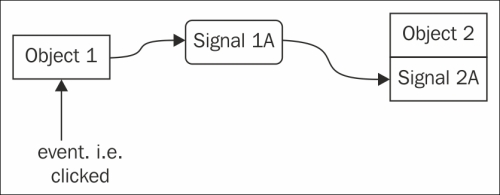Qt Signal Slot Connection Type
Introduction
Remember old X-Window call-back system? Generally it isn't type safe and flexible. There are many problems with them. Qt offer new event-handling system - signal-slot connections. Imagine alarm clock. When alarm is ringing, signal is sending (emitting). And you're handling it as a slot.


Qt::AutoConnection: If the receiver lives in the thread that emits the signal, Qt::DirectConnection is used. Otherwise, Qt::QueuedConnection is used. The connection type is determined when the signal is emitted. Qt::DirectConnection: This slot is invoked immediately when the signal is emitted. The slot is executed in the signaling thread. When a signal - slot connection is established, Qt internally maps the arguments to the SIGNAL and SLOT macros to integer method IDs. The details of the connection, including the receiver, connection type and method IDs of the signal/slot are then stored in a connection object and added to a list maintained by the sender.

- Every QObject class may have as many signals of slots as you want.
- You can emit signal only from that class, where signal is.
- You can connect signal with another signal (make chains of signals);
- Every signal and slot can have unlimited count of connections with other.
- ATTENTION! You can't set default value in slot attributes. e.g.
void mySlot(int i = 0);
Qt Signal Slot Connection Types
Qt Signal/Slot Connectons If this is your first visit, be sure to check out the FAQ by clicking the link above. You may have to register before you can post: click the register link above to proceed. Signals and slots are loosely coupled: A class which emits a signal neither knows nor cares which slots receive the signal. Qt's signals and slots mechanism ensures that if you connect a signal to a slot, the slot will be called with the signal's parameters at the right time. Signals and slots can take any number of arguments of any type.
Connection
You can connect signal with this template:QObject::connect ( const QObject * sender, const char * signal, const QObject * receiver, const char * method);You have to wrap const char * signal and const char * method into SIGNAL () and SLOT() macros.
And you also can disconnect signal-slot:QObject::disconnect ( const QObject * sender, const char * signal, const QObject * receiver, const char * method);
Deeper
Widgets emit signals when events occur. For example, a button will emit a 'clicked' signal when it is clicked. A developer can choose to connect to a signal by creating a function (a 'slot') and calling the connect() function to relate the signal to the slot. Qt's signals and slots mechanism does not require classes to have knowledge of each other, which makes it much easier to develop highly reusable classes. Since signals and slots are type-safe, type errors are reported as warnings and do not cause crashes to occur.
For example, if a Quit button's clicked() signal is connected to the application's quit() slot, a user's click on Quit makes the application terminate. In code, this is written as
Qt Signal Slot Connection Type
connect(button, SIGNAL (clicked()), qApp, SLOT (quit()));
Connections can be added or removed at any time during the execution of a Qt application, they can be set up so that they are executed when a signal is emitted or queued for later execution, and they can be made between objects in different threads.

The signals and slots mechanism is implemented in standard C++. The implementation uses the C++ preprocessor and moc, the Meta-Object Compiler, included with Qt. Code generation is performed automatically by Qt's build system. Developers never have to edit or even look at the generated code.